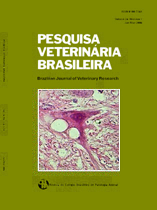 |
|
|
|
Year 2012 - Volume 32, Number 12
|

|
Characterization of Haematobia irritans and Rhipicephalus (Boophilus) microplus control in Triângulo Mineiro and Alto Paranaíba, Minas Gerais, 32(12):1246-1252
|
ABSTRACT.- Domingues L.N., Bello A.C.P.P., Cunha A.P., Leite P.V.B., Barros A.T.M. & Leite R.C. 2012. [Characterization of Haematobia irritans and Rhipicephalus (Boophilus) microplus control in Triângulo Mineiro and Alto Paranaíba, Minas Gerais.] Caracterização do controle de Haematobia irritans e Rhipicephalus (Boophilus) microplus no Triângulo Mineiro e Alto Paranaíba, Minas Gerais. Pesquisa Veterinária Brasileira 32(12):1246-1252. Departamento de Medicina Veterinária Preventiva, Escola de Veterinária, Instituto Nacional de Ciência e Tecnologia de Informação Genético-Sanitária da Pecuária Brasileira, Universidade Federal de Minas Gerais, Av. Antônio Carlos 6627, Cx. Postal 567, Campus Pampulha, Belo Horizonte, MG 30123-970, Brazil. E-mail: dominguesln@gmail.com
The effective control of Haematobia irritans (horn fly) and Rhipicephalus (Boophilus) microplus (cattle tick) is crucial for increasing the productivity of livestock industry in Brazil, but still remains a challenge. A greater knowledge about parasite control in the field is necessary to establish control strategies closer to farmer’s reality and easier to be performed. This study characterized the practices adopted for controlling such ectoparasites on 23 cattle ranches from the Triângulo Mineiro and Alto Paranaíba region in the state of Minas Gerais, through interviews. Most interviewees recognized the importance of these parasites to livestock, however, many problems related to parasite control were observed. Control of horn flies and cattle tick was a routine in 17.4% and 95.7% of the ranches,
respectively, triggered by high infestations on animals. More than six insecticide/acaricide treatments were applied yearly in all cattle ranches controlling horn flies and in 76.5% of the ranches controlling the cattle tick. Pesticide products were applied mostly by manual backpack sprayers (63.6%) without restraining the animals in 45.5% of ranches. Product dilution following manufacturer’s recommendations was performed by 45.5% of interviewees, but 63.6% of them used lower doses per animal than technically recommended. Associations of organophosphates and pyrethroids were the main products used to control both parasites. Although pesticide use was a routine practice, the use of personal protective equipment (PPE) was not common among surveyed people. Most interviewees were able to recognize epidemiological characteristics of the parasites; however, parasite control measures adopted at most cattle ranches tend to jeopardize the efficacy of products, susceptibility of parasites and sustainability of control programs. |
| |
|
|
| |
|
 |